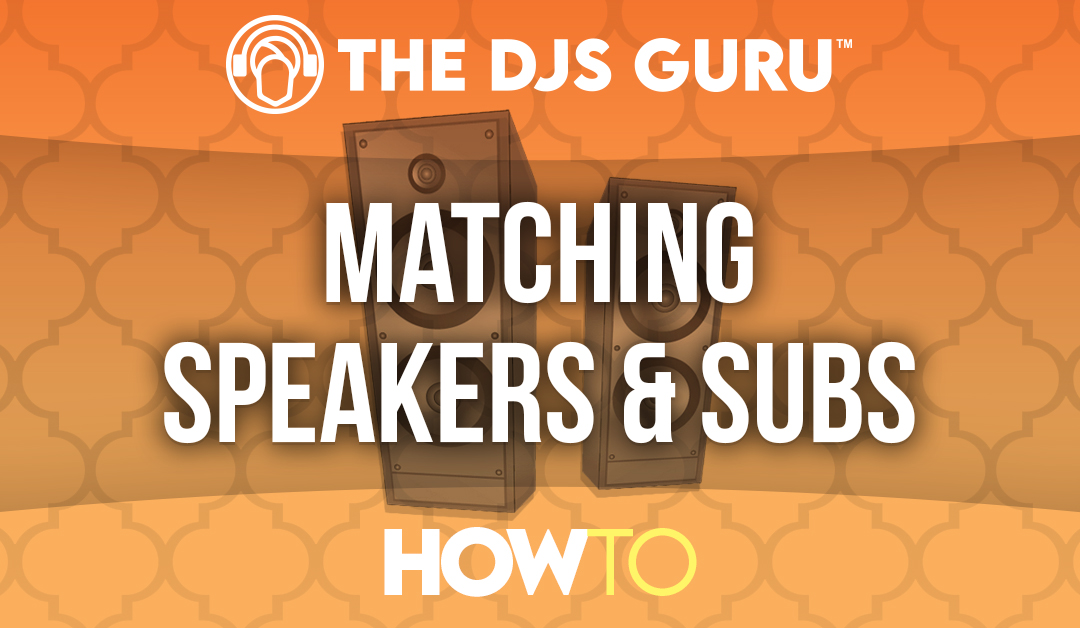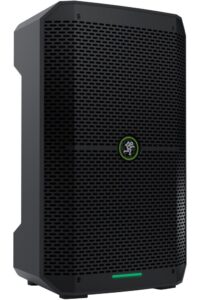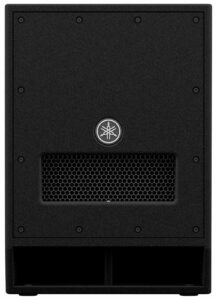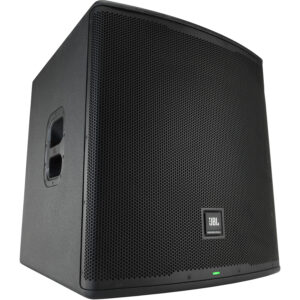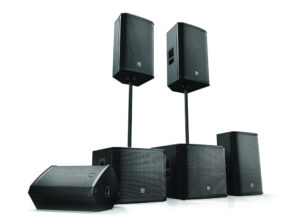As DJs, we love speakers and subwoofers. Often, our love turns into a “the more the better” and “the bigger the better” mentality. But when it comes to creating a great sound system, there are a few key principles to keep in mind. Speakers and subwoofers come in various shapes and sizes – some work well together, others not so much. In this article, we’ll talk about the different speaker and subwoofer sizes and matching speakers and subwoofers to each other. We’ll also cover some of the best applications for each PA setup.
Speaker Sizes
PA speakers, whether powered or unpowered, come in 5 main sizes. The size of a speaker is based on the diameter of the woofer, which produces the lower frequencies in the musical spectrum. While it’s true there are outliers to the basic lineup, the vast majority of speakers will be either 8″, 10″, 12″, 15″, or dual 15″. These sizes exist along a spectrum, with increasing size offering distinct benefits but bringing along with it some downsides.
8″ – Normally the smallest speaker cabinet regularly used by DJs and bands. These tiny tops are super portable and light, making them easy to transport and setup. They reproduce speech well, making them a great choice for wedding ceremonies and corporate conferences. Their biggest downside is their lack of bass. Low notes simply require larger speaker cones to be produced.
10″ – The second smallest speaker cabinet is super versatile. The extra 2″ allows the speaker to extend deeper, making music reinforcement more full. Yet, they are still small enough to transport and setup easily by almost anyone.
12″ – The 12″ PA speaker is the everyman’s speaker. They’re super common and can be found in almost every application imaginable. A 12″ woofer is big enough to reproduce most music reasonably well and produce a substantial output for both speech and playback. If you had to choose only one speaker to buy for DJing or a band, choose a 12″.
15″ – A 15″ PA speaker is popular in the DJ space but in our opinion is sort of a black sheep. The 15″ woofer is supposed to offer increased low frequency extension, which it does. Unfortunately, it often comes at the expense of muddy lows and mids due to competition of these frequencies for the single woofer cone.
Dual 15″ – The dual 15″ (or 15″ 3-way cabinet) is a beast. It’s big, heavy, and means business. You’ll often see them stacked on subwoofers at large school dances or outdoor concerts. An extra woofer brings increased output (that is, if you can manage the weight).
Subwoofer Sizes
Subwoofers are a little bit easier to keep track of. In the pro audio world, you’ll see 3 main sizes – 12″, 15″, and 18″. However, to be honest, almost all gigging DJs are going to be using either 15″ or 18″ subwoofers. Subwoofers extend into lower frequencies than main speakers and can do so much more efficiently. Because they sit directly on, or “couple”, to the floor, they provide increased low-end output and power. They also free up the woofer cone and amplifier in the main speakers to be more efficient, allowing your entire setup to run louder and more cleanly.
12″ Sub – These small subwoofers are mostly seen as either bases in column array speakers or paired with 8″ or 10″ speakers. Their main benefit is (obviously) compactness, but due to their tiny size they simply don’t reach low enough to reproduce most sub-bass frequencies. They have a use in slimmed-down, sleek event setups, but aren’t as versatile as their big brothers. They often run out of juice before the main speakers, and you won’t see too many of them in use at actual events.
15″ Sub – The 15″ subwoofer is the smaller of the 2 mainstream pro audio subwoofer sizes. 15″ is a point where the sub can dig deep enough to faithfully reproduce most music (besides some hip-hop and EDM). While they won’t extend all the way to the deepest notes, they will round out a system much more than a pair of 15″ top speakers will. Many 15″ subs are still small enough that they can fit in your average SUV or crossover, making them usable for the average mobile DJ.
18″ Sub – The 18″ subwoofer is the gold standard in low-end punch. 18″ subwoofers are no joke – they’re bulky and large and often require a big SUV, van, or truck to transport. What they lack in portability, however, they make up in performance. 18″ subwoofers can reach down to the lowest beats and kick drums in hip-hop and EDM and offer sound pressure levels (SPLs) not seen in smaller subwoofers. They also usually pack more amplifier power and can keep up with the main speakers better than smaller subs. You can also buy them in dual 18″ configurations for even more punch.
Matching Speakers and Subwoofers
We’ll preface this section by saying there aren’t any hard and fast rules when it comes to matching speakers and subwoofers. You could technically hook a pair of 8″ tops to 18″ subs if you wanted. However, thinking of the goals and intended uses of your system when matching speakers and subs will help you create a system optimized for the types of events you perform.
What we are proposing isn’t rocket science – small speakers work best with smaller subwoofers. Each woofer size has an optimal range of frequencies it will reproduce, especially on the low end. Putting speaker and subwoofer sizes together that are closer in diameter will result in the most cohesive playback. Regardless of what sizes you match up, it’s important to use the subwoofer crossover to make sure that the main speakers are only receiving the frequencies above what the subwoofer is producing. You can read more about our top-powered speakers here.
8″ and 10″ speakers – The smallest of DJs speakers pair well with, you guessed it, small subwoofers. One of the only times we really recommend using the 12″ subwoofer would be when mixed with an 8″ or 10″ top. This creates a sort of “micro” system that would work well for intimate coffee-house gigs and wedding receptions with small crowds. The small subwoofer, coupled to the floor, will fill out the mid- and high-heavy response of the small tops. You could also pair these speakers with a 15″subwoofer for even more extension and power.
12″ speakers – The do-it-all 12″ speaker pairs nicely with either a 15″ or 18″ subwoofer. A 12″ subwoofer wouldn’t really offer much in the way of increased extension, and the similar sizes might looked mismatch. Additionally, if you were using the top with a pole above the woofer, it may be unstable. Again, opting for the 15″ sub might be the best option if you need low-end reinforcement but are constrained by your vehicle. However, I would say that the 12″ speaker and 18″ subwoofer is the most widely-used and potent combination for almost any application.
15″ and dual 15″ speakers – There really is only one option when it comes to 15″ speakers, and that’s 18″ subwoofers. Anything else would both look awkward and not offer any real benefit. 15″ tops and 18″ subs is a powerhouse combination that’s imposing to look at and takes up a lot of space, both in your vehicle and in the venue. Like we mentioned before, you’ll see this combo commonly at large outdoor events, school dances, concerts, and more.
Should The Brands Match?
A common question that we get is “Should my speaker and subwoofer brands match?” Again, there are no hard and fast rules and no subwoofer police are going to come after you for mixing speakers and subs from different brands. However, we will say that most speaker brands have their unique sound signature.
The shape, size, and material of the speaker cabinet can all change the tone of the speaker. When speaker and subwoofer brands match, the sound is smoother and more balanced. Many speaker manufacturers even build settings into the speaker and subwoofer DSPs (digital signal processors) that perfectly match up their frequencies so the transition between the two is seamless. This is possible to achieve with mismatched brands, but keeping everything in the same family makes the process easier and better sounding.
Click here to visit our partner site DJSupplyStore.com
Speaker and Subwoofer Matching – How Many Subs?
Another important aspect of matching speakers and subwoofers is the number of cabinets. The most common configurations are 2-1, 2-2, and 2-4. 2-1 means that a pair of top speakers is paired with a single subwoofer, often placed in the center between the stereo mains. The single sub extends the low frequencies and takes some work away from the tops, improving the overall efficiency of the system. However, the single sub will often run out of steam before the tops.
In a 2-2 system, there are a pair of mains and a pair of subwoofers working together. The subs can either be placed directly below each top cabinet or coupled together in the center for more power. This more closely matches the output of the mains and subwoofers, plus the symmetry of a pair of mains over a pair of subs looks great.
Lastly, a 2-4 system utilizes a pair of subwoofers for each main speaker. This can result in monstrous bass that allows the main speaker to work to their full potential. When using larger 15″ tops and 18″ subs, a 2-4 system ensures maximum output and sound pressure for the most demanding of scenarios.
Don’t Forget SPLs!
Last but not least, it’s also important to make sure you’re matching up the power levels of your speaker and subwoofers. This does not mean your speakers need to have the same wattage. We’ve said it in the past, but watts don’t equal output. Instead, it’s important to match up the SPL (sound pressure level) between your system. SPL is measured in decibels (dB), and while your speaker and sub don’t have to be an exact match, they should be in the same ballpark. For more on how to run proper event sound, click here.
Speakers from a company’s lowest line, for example, may fall somewhere around 118db to 125db peak levels. These speakers would be quickly outpaced by a manufacturer’s top-of-the-line subwoofers that can crank out 135db. That 10db difference equates to a DOUBLING in volume, meaning that when it comes to high levels the subwoofers and tops will be awkwardly mismatched. Alternatively, linking powerful main speakers with budget subwoofers will create an even bigger differential, because, as we mentioned before, subwoofers often reach their limits before top cabinets. Instead, try pairing speakers and subwoofers from similar price categories – often, this causes their SPL levels to more closely align with each other and produce a more balanced sound. Getting the speaker’s max SPL rating within 3-5 dB is probably a good goal to shoot for.
Matching Speakers and Subwoofers – Final Thoughts
If you’re looking to buy your first PA system or add subwoofers to your existing speakers, we hope this quick guide has been helpful. While the principles are simple, when done correctly they can make your system sound immensely better. Not only will it sound better, but well-matched speakers and subwoofers will be more aesthetically pleasing as well. When done right, it will elevate the sonic experience that you deliver to each of your clients.

